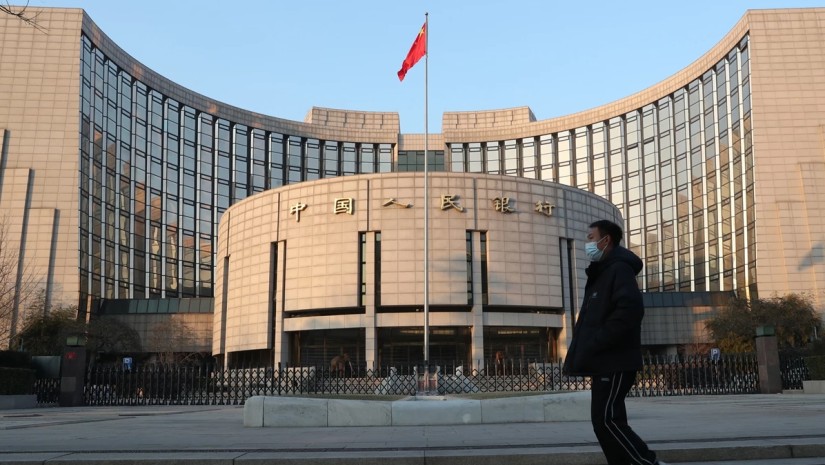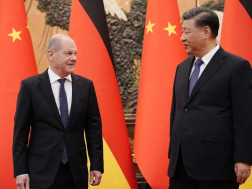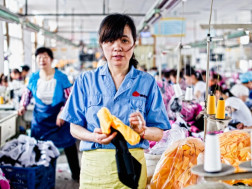China has set an ambitious economic expansion target of “around 5%“ for 2024, as its leaders vowed to “transform the growth model” in the face of significant challenges facing its development.
The figure — similar to last year’s growth target — was announced by Chinese Premier Li Qiang on Tuesday at the opening of the annual gathering of the National People’s Congress (NPC), the country’s rubber-stamp legislature, which draws nearly 3,000 delegates to Beijing for a week-long meeting.
“Stability is of overall importance, as it is the basis for everything we do,” Li said during the delivery of his maiden work report. “In particular, we must push ahead with transforming the growth model, making structural adjustments, improving quality, and enhancing performance.”
Li’s proclamation comes as Beijing is seeking to boost confidence in China’s economy, while grappling with a troubled property sector, deflationary pressures, an exodus of foreign capital, a battered stock market and a record low birth rate.
He delivered the report to an auditorium filled with delegates inside the cavernous Great Hall of the People. Delegates clapped in unison in time with a military band serenade as top leadership entered the room in a line led by Chinese leader Xi Jinping.
The political heart of Beijing, where the event is taking place, was under heavy security ahead of the event, with barricades and traffic controls restricting access to the public square and surrounding government buildings.
At the event, China also unveiled its annual military budget for 2024, which will increase by 7.2% to 1.67 trillion yuan ($230.6 billion), according to a draft report released separately. The growth rate for the defense budget is the same as last year’s.
The gross domestic product (GDP) target and military spending are among the most closely watched figures during the opening day of proceedings.
But investors appear to be disappointed about the lack of major stimulus measures. Hong Kong’s benchmark Hang Seng Index fell 2.6% by afternoon trade, the worst performer in Asia. The Hang Seng Tech Index sank 4%.
A highly ambitious target
A target of “around 5%” is ambitious but achievable, said Larry Hu, chief China economist at Macquarie Group.
“(It) entails more aggressive easing measures than last year. As a result, it may also improve the growth outlook among households and corporates,” he said.
Last year, China also set an “around 5%” target, in what was then the country’s lowest numerical target announced in decades. Earlier this year, it said economic growth had reached 5.2% in 2023.
Meeting a similar target in the coming year, however, could be significantly tougher. In 2022, Covid-19 restrictions in the country were rampant, setting a low base of comparison for last year. Some international analysts are also skeptical about the reliability of China’s growth figures, as the government is widely seen as having limited data transparency.
Premier Li admitted that achieving the growth targets “will not be easy.”
“In setting the growth rate at around 5%, we have taken into account the need to boost employment and incomes and prevent and defuse risks,” he added.
China’s economic challenges have generated hardship and frustration as young people struggle to find jobs, investors grapple with market losses and small business owners fight to stay afloat.
No major stimulus measures were announced, but Li said the government would “stabilize and expand” consumption, while targeting an increase in spending on big-ticket items including electronics and new-energy vehicles.
The government set the fiscal budget deficit at 3% of GDP for 2024. This is lower than the revised deficit of 3.8% in 2023, but the same as the 3% target initially announced last year.
The target may indicate Beijing’s caution over debt sustainability, as policymakers try to strike a balance between stabilizing growth and controlling debt, analysts said. In December, Moody’s downgraded China’s credit rating outlook from “stable” to “negative,” citing risks from financially stressed local governments and state-owned enterprises.
To boost government spending for major projects, Li announced a plan to issue 1 trillion yuan ($139 billion) of ultra-long special central government bonds this year, the first such sale since 2020.
Local governments will also be allowed to issue 3.9 trillion yuan ($542 billion) of special bonds, which would be mainly used for infrastructure spending. That’s an increase of 100 billion yuan ($13.9 billion) from last year.
“The NPC did not bring any major surprises to investors but raised doubts about achieving the ambitious 5% growth target without the increasing fiscal deficit ratio,” said Ken Cheung, chief Asian foreign exchange strategist at Mizuho Bank. “While the total increase in 1.1 trillion yuan bond issuances provides extra funding to bolster infrastructure investments, there is no big stimulus plan to support growth.”
Recent years have seen national security interests, Covid-19 controls and efforts to tighten government control over industries like technology, entertainment and real estate all take priority for Xi — at times over business growth and economic expansion.
Li also appeared to nod to criticism that China had gone too far toward prioritizing national security at the cost of economic growth, calling for the country to “ensure that high-quality development and greater security reinforce each other.”
As part of its strategic goals, China boosted its annual budget for science and technology by 10% to an unprecedented 370.8 billion yuan ($51.6 billion) — the biggest increase since 2019 after years of minimal growth.
“We will move faster to boost self-reliance and strength in science and technology,” Li said. “We will fully leverage the strengths of the new system for mobilizing resources nationwide to raise China’s capacity for innovation across the board.”
Li also vowed to bolster efforts in big data and artificial intelligence (AI) and launch a number of major science and technology programs.
The emphasis on self-reliance in science and technology comes after the United States tightened control over the export of cutting-edge technologies to China, especially in the field of AI, which Washington said could be used to strengthen the Chinese military.
The Biden administration has restricted American companies from selling advanced semiconductor chips to China and banned US investment in China in sensitive technologies including AI, quantum computing and semiconductors.
A bigger budget
China’s 7.2% growth rate in military spending is in line with several previous years of similar single-digit increases.
Beijing hasn’t announced double digit growth in military spending since 2015, when there was a push to revamp the armed forces.
Yun Sun, director of the China program at the Stimson Center think tank in Washington, said that given China’s economic slowdown, a 7.2% increase is fairly significant.
“The overall percentage of defense spending in GDP is still smaller than those of the US and Russia, but the ratio is nevertheless growing,” she said.
The US authorized an $886 billion defense budget for 2024, up about 3% from the previous year.
The expansion of China’s defense budget has outpaced its target economic growth for years, with this year being no exception.
Nevertheless, it has not reached the stage where it is overburdening the national coffers, said James Char, a research fellow at the S. Rajaratnam School of International Studies in Singapore and an expert on the Chinese military.
“Of course, the country’s longer-term economic fortunes will determine whether this can be sustained going forward,” he said.
China’s leaders are watching what they see as an increasingly fractious geopolitical environment, ranging from America’s closer alliances with Beijing’s neighbors, growing friction with the Philippines over contested South China Sea waters and rising tension globally amid major conflicts in the Middle East and Ukraine.
Beijing has repeatedly pushed back against characterizations that it is aggressively ramping up military spending. Rather, it seeks to project an image of itself as a proponent of peace, despite its own aggression in places like the South China Sea and toward the self-ruled island of Taiwan.
NPC spokesperson Lou Qinjian told reporters in Beijing on Monday that “compared with major military powers, such as the United States, China’s defense spending is quite low, whether as a percentage of GDP or total budget, or in terms of per citizen or per service member expenditure.”
Outside estimates in recent years have suggested higher actual spending than official figures indicate. The official figure does not include a breakdown of military spending, making it difficult to make direct comparisons.
China’s military has also had a tumultuous year.
Multiple high-ranking officials and defense executives were removed from their positions either in the armed forces or political bodies in recent months alongside an anti-corruption drive and apparent purge. Those ousted included then-Defense Minister Li Shangfu, who was removed from his post without explanation.
The fallout has been felt at the NPC.
Last week, Lt. Gen. Li Zhizhong, the deputy commander of the Central Theater Command, was removed as a member of the congress. He formerly served as the head of the equipment department of the People’s Liberation Army (PLA) Ground Force and was the tenth senior PLA officer to have been ousted from the legislative body in recent months.
xfAnd since December, four senior figures in the defense industry have been dismissed from the Chinese People’s Political Consultative Conference, the top advisory body to the congress.
“If our assumptions about extensive corruption and wastage in China’s military-industrial complex are correct, the PLA high command will likely prioritize the imposition of tighter resource management above all else,” Char said.
Source: CNN
















